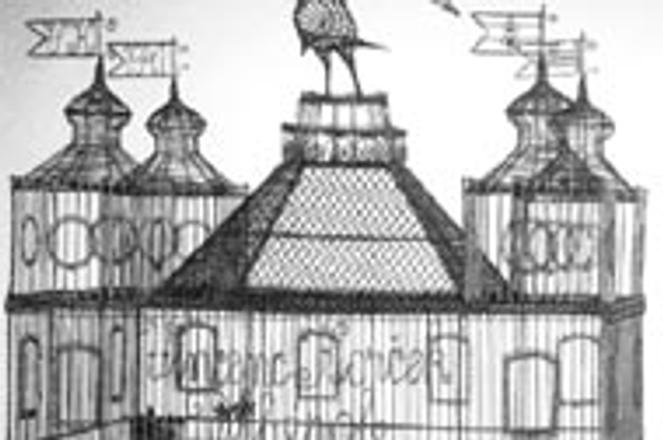"Bird Cage," made by tinker Vincent Korček in 1941.Courtesy Grafobal
Though tinkers have always had a place in medieval folklore, one gets the feeling from folk tales that they were rather close to the bottom of the heap, socially speaking. Hauling their carts from village to village, hump-shouldered and filthy, they can scarcely have attracted more than grudging acceptance from central Europe's well-off burghers.
But the relics which survive of these dimly-remembered people and their trade display an intricate and creative skill. Indeed, the history of tinkers ("drotári") in Slovakia is one of considerable importance to the country's historically poorest regions, Kysuce in the north and Trenčín in the west.
The tinker's trade was a travelling one, and arose as a result of Slovakia's grinding poverty under its feudal Hungarian landlords. At the end of the 17th century, Slovak men from the villages of Kolárovice, Veľké Rovné and Dlhé Pole in western Slovakia went to work in the wire mills of Moravian Silesia. There they learned the qualities of the new wire and adapted it to many uses, including the mending of broken pottery by binding the pieces together with wire coils.
Soon, the first wire gratings (for windows, fireplaces) were conceived and produced by these tinkers, who had the knack of twisting and interweaving wire to produce cunning shapes. Trade flourished well into the 18th century, and it is said that upon the birth of Austro-Hungarian Emperor Joseph II (1780-1790), tinkers presented a proud Empress Maria Theresa with a beautiful cradle made of fine wire. Given a single push, the cradle would rock continuously, balanced by two weighted balls. In thanks for the gift, tinkers were given the freedom to wander at will throughout the monarchy.
During the late 18th century, Slovak tinkers travelled throughout Europe and indeed around the entire globe. The wandering tinker had no fixed destination, but went wherever his fancy took him, knowing that his trade would always be in demand.
The tinkers also gradually improved their techniques to such an extent that they were able to repair porcelain objects such as plates and vases. For this kind of work they used a stainless brass wire, which also improved the aesthetic quality of the mended object. Particularly noteworthy was the manner in which the tinkers wired procelain pipes, an operation requiring great care.
Budatín Castle in Žilina houses the permanent Tinkers' Trade Exhibition.Courtesy Grafobal
A milestone in the development of their trade was the movement towards the production of new wire, tin and plumbing appliances. The early 19th century saw the beginning of small-scale production, which eventually led to factory works. By the turn of the 20th century, great tinkers' workshops had arisen in germany, Belgium, Poland, Russia and the Balkans. Beyond these countries, about 250 such factories existed in the rest of Europe and between 30 and 40 smaller shops in North America.
According to popular history (no doubt encouraged by the factory owners), the social well-being of the workers was a very important matter to their employers. Tinker factory employees received free board and lodging, as well as free laundry service. The master-tinker encouraged personal hygiene and good behaviour. After completing his apprenticeship, a tinker was usually granted a holiday with free return travel. The master-tinker also ensured that adequate moeny was regularly sent to the workers' families. From all over the world, tinkers sent their savings back to their native villages in Slovakia, sustaining the economy of one of the poorest regions in Europe.
Many tinkers went beyond the purely practical in their work, and demonstrated a feeling for aesthetic form and colour. They produced unique works of art made of wire, tin and iron, drawing inspiration from the plants and animals and the lace and knitted works of their region.
These days, the tinker's craft is still practiced in Trenčín and Žilina regions, and is being resuscitated by a company in Veľké Rovné. Modern day works, as well as those from hundreds of years ago, are now on display at the permanent Tinkers' Trade Exhibition at Budatín Castle in Žilina. Situated on the confluence of the Váh and Kysuca Rivers, the exhibition is open every day except Monday from 08:00 until 16:00. Take bus No. 22 from the railway station. Admission is a modest 10Sk for adults and 4Sk for children.


